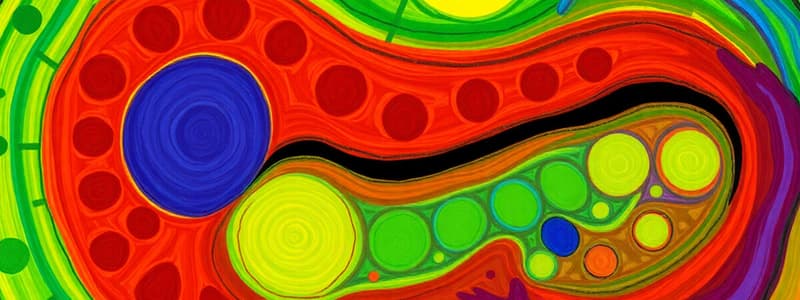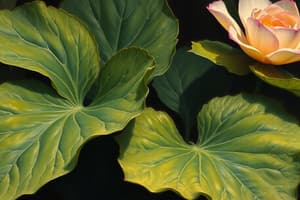Podcast
Questions and Answers
In a plant cell, what condition results in the highest Diffusion Pressure Deficit (DPD)?
In a plant cell, what condition results in the highest Diffusion Pressure Deficit (DPD)?
- Turgid cell (OP = TP)
- Plasmolyzed cell (TP has a negative value) (correct)
- Flaccid cell (TP = 0)
- Normal cell (DPD = OP - TP)
Consider two solutions, A and B, separated by a semi-permeable membrane. Solution A has a higher water concentration than Solution B. Which of the following statements accurately describes the expected net movement of water?
Consider two solutions, A and B, separated by a semi-permeable membrane. Solution A has a higher water concentration than Solution B. Which of the following statements accurately describes the expected net movement of water?
- There will be no net movement of water as the system is at equilibrium.
- Water will move from Solution A to Solution B due to higher osmotic pressure in Solution B. (correct)
- Water will move from Solution B to Solution A due to lower osmotic pressure in Solution A.
- Water will move from Solution B to Solution A due to higher osmotic pressure in Solution A.
Using the van't Hoff equation, which scenario would result in the highest osmotic pressure?
Using the van't Hoff equation, which scenario would result in the highest osmotic pressure?
- A non-electrolyte solution with a molarity of 0.1 M at 0°C.
- An electrolyte solution (i=2) with a molarity of 0.1 M at 25°C. (correct)
- A non-electrolyte solution with a molarity of 0.1 M at 25°C.
- An electrolyte solution (i=2) with a molarity of 0.05 M at 25°C.
A cell is placed in a solution. Initially, the osmotic pressure inside the cell is higher than the osmotic pressure of the surrounding solution but the cell hasn't reached its maximum volume. What direction will the net water movement occur, and what will be the effect on turgor pressure?
A cell is placed in a solution. Initially, the osmotic pressure inside the cell is higher than the osmotic pressure of the surrounding solution but the cell hasn't reached its maximum volume. What direction will the net water movement occur, and what will be the effect on turgor pressure?
What is the relationship among osmotic pressure (OP), turgor pressure (TP), and diffusion pressure deficit (DPD) in a plant cell at equilibrium?
What is the relationship among osmotic pressure (OP), turgor pressure (TP), and diffusion pressure deficit (DPD) in a plant cell at equilibrium?
Which of the following best explains why bacterial and plant cells do not typically burst when placed in a hypotonic solution?
Which of the following best explains why bacterial and plant cells do not typically burst when placed in a hypotonic solution?
A student is studying osmosis using a U-shaped tube separated by a semi-permeable membrane. Initially, side A contains pure water, and side B contains a sucrose solution. If the experiment is allowed to proceed undisturbed, what will be the state after equilibrium is reached?
A student is studying osmosis using a U-shaped tube separated by a semi-permeable membrane. Initially, side A contains pure water, and side B contains a sucrose solution. If the experiment is allowed to proceed undisturbed, what will be the state after equilibrium is reached?
If a plant cell has an osmotic pressure (OP) of 10 atm and a turgor pressure (TP) of 6 atm, what is its diffusion pressure deficit (DPD)?
If a plant cell has an osmotic pressure (OP) of 10 atm and a turgor pressure (TP) of 6 atm, what is its diffusion pressure deficit (DPD)?
Which of the following sequences correctly orders plants from the highest to lowest osmotic pressure?
Which of the following sequences correctly orders plants from the highest to lowest osmotic pressure?
When calculating osmotic pressure using the van't Hoff equation for an electrolyte like NaCl, what does the ionization constant ('i') represent?
When calculating osmotic pressure using the van't Hoff equation for an electrolyte like NaCl, what does the ionization constant ('i') represent?
Flashcards
Osmosis
Osmosis
Movement of solvent (typically water in biological systems) across a semi-permeable membrane from an area of high water concentration (hypotonic) to an area of low water concentration (hypertonic).
Osmotic Pressure (OP)
Osmotic Pressure (OP)
The pressure required to stop the flow of water across a semi-permeable membrane due to osmosis, directly proportional to solute concentration.
Exo-osmosis
Exo-osmosis
Water moves out of the cell due to a higher solute concentration outside.
Endo-osmosis
Endo-osmosis
Signup and view all the flashcards
Van't Hoff Equation (Non-Electrolyte)
Van't Hoff Equation (Non-Electrolyte)
Signup and view all the flashcards
Van't Hoff Equation (Electrolyte)
Van't Hoff Equation (Electrolyte)
Signup and view all the flashcards
Turgor Pressure (TP)
Turgor Pressure (TP)
Signup and view all the flashcards
Wall Pressure (WP)
Wall Pressure (WP)
Signup and view all the flashcards
Diffusion Pressure Deficit (DPD)
Diffusion Pressure Deficit (DPD)
Signup and view all the flashcards
Water Movement and DPD
Water Movement and DPD
Signup and view all the flashcards
Study Notes
No new information was provided for this update. The provided text is identical to the existing notes.
Studying That Suits You
Use AI to generate personalized quizzes and flashcards to suit your learning preferences.




